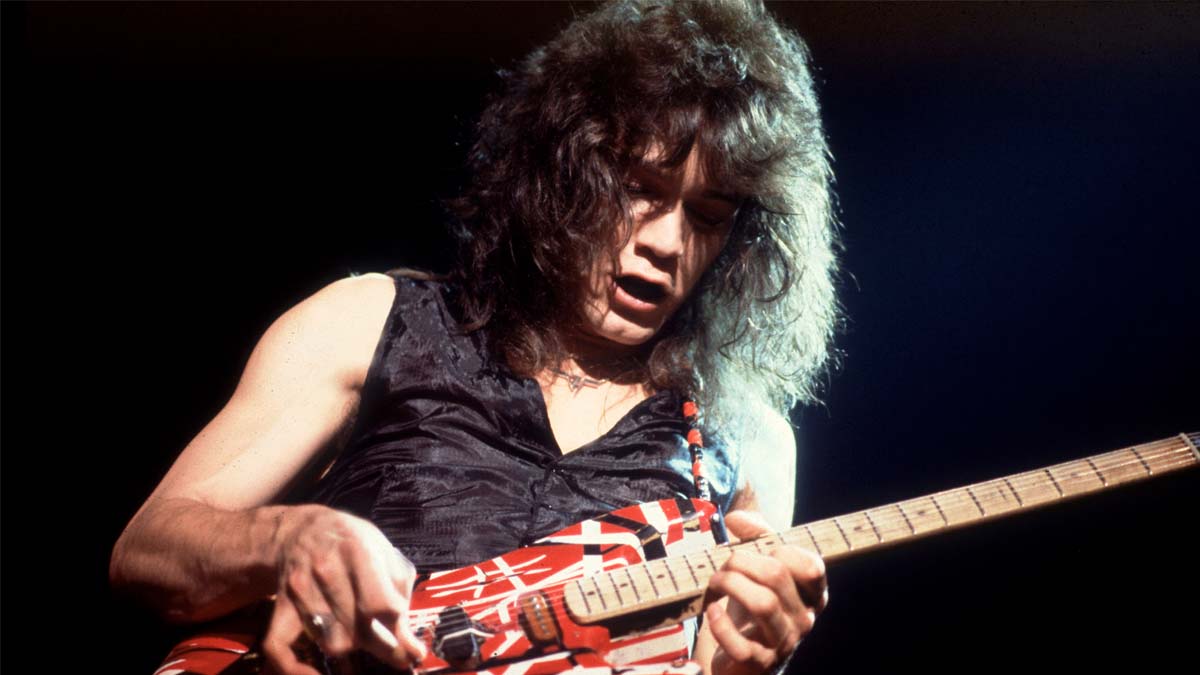Get to the roots of Eddie Van Halen’s groundbreaking playing with this lesson on his biggest influences
In six immersive studies, we approach Eddie’s playing style from the perspective of the players he idolized

It’s a fascinating question to consider who influenced Eddie Van Halen. How did he develop his unique playing approach? Did he stumble across everything by accident?
In this lesson we attempt to look at who some of those influences were, how they informed Eddie’s journey and how he then pushed those ideas forward to a whole new school of players.
It is well documented that Eddie was a huge fan of the blues-rock icons of the ’60s and ’70s, and much of Van Halen’s songwriting approach is clearly grounded in this style.
Eddie’s most commonly cited early guitar hero is Eric Clapton; in interviews he always cited EC as his great early inspiration, but he was also a great fan of Jimmy Page, Ritchie Blackmore and indeed Allan Holdsworth.
As any fan of Eddie will know, the backbone of his vocabulary lies in a fiery blues-rock vocabulary. Before Van Halen were Van Halen, Eddie was known for being able to play almost every Cream solo note for note, and there are multiple recordings of interviews where he plays the entire Crossroads solo. In fact, he is quoted as dedicating his bluesy solo on the song When It’s Love to Clapton himself, as a tribute to his legacy and influence.
Eddie was also a huge fan of Led Zeppelin, and there’s no doubt that they had a big influence on his riff writing and songs. It’s also possible to speculate that Jimmy is where Eddie’s inspiration for expressive techniques came from.
The Heartbreaker solo in particular features many sounds that are staples in Eddie’s own arsenal; tapped notes with large bends, pick slides and wide vibrato. If you’ve not heard it for a while, it’s worth digging it out and reminding yourself.
However, it wasn’t just the blues-rock players of his youth that inspired Eddie. He was also captivated by jazz-fusion heavyweight, Allan Holdsworth. Allan was an incredibly accomplished legato player and experimented with all sorts of unconventional tonalities.
It was his use of wide stretches and symmetrical shapes that created very angular and interesting sounds that caught Eddie’s ear, and was something that he tried to emulate in his own way.
Many of the scale fingerings he liked to draw on are unconventional and won’t be be found in any typical text book, but they make it easier to execute faster lines while also creating unexpected angular sounds that keep things sounding fresh and less exercise based.
Of course we cannot discuss the great Eddie without mentioning his pioneering approach to two-handed tapping. Of course it had been dabbled with by other players as previously mentioned, plus Les Paul and others before him.
But Eddie brought into the spotlight an otherwise unheard-of technique that allowed him to play large arpeggio sequences reminiscent of the classical music he first learned in his formative years in Holland.
It was also possibly his way of replicating some of the arpeggio approaches he would have heard listening to tracks like Deep Purple’s Highway Star – an approach previously only heard on keyboards and not on electric guitar.
Our six studies focus specifically on these particular stylistic and technical influences, with the final piece combing elements from all five approaches.
Get the tone
Amp settings: Gain 6, Bass 5, Middle 6, Treble 5, Reverb 4
To get close to Eddie’s sound, you don’t necessarily need a Marshall Plexi or a Peavey 5150. Any good Marshall-esque tone will suffice. The key to Eddie’s sound relies heavily on the fire of your delivery.
Use less preamp gain than you think, then you’ll have to put more power into your pick attack and vibrato to get the notes to scream. If using a cleaner amp, go for a strong drive pedal like a Boss SD-1 or Fulltone OCD.
Example 1. Pop-rock influences
This study tips its hat towards Eddie’s ’60s songwriting influences ranging from bands like the Kinks (Dave Davies) and The Beatles through to The Who (Pete Townshend). This study is mostly stock blues-rock vocabulary, but with wide vibrato to make it more aggressive and punchy.
In bars 4-6, there is a big stretch for the descending hammer-on line. Make sure the thumb on the back of the neck is lined up with your second finger to enable maximum stretch.
Example 2. Eric Clapton influence
Eddie always spoke about how it was Eric Clapton and not perhaps the more expected Jimi Hendrix that was his number one lead guitar influence. So this study is essentially a blues solo, but with a bit of Eddie’s extra edge to the tone and delivery of the more rocky vibrato than that of Clapton.
The licks are definitely there though! Look out for the deliberate staccato versus legato notes, as well as the slides in particular to get the solo sounding ‘Creamily’ authentic.
Example 3. Jimmy Page influence
Here we are purposefully exploring the ‘tapped bends’ approach that Eddie used a lot. This study is great for developing muscle memory and accuracy when combining bending and tapping techniques.
To achieve vibrato with a tapped note, it is the fretting hand that still provides the power and movement. The picking hand follows what the fretting hand is doing. If it’s the other way around then vibrato would be more difficult to achieve and control.
Example 4. Allan Holdsworth influence
Here we focus on symmetrical shapes and wide stretches. To make the larger stretches, make sure your thumb is in the middle of your fretting hand on the back of the neck, so your fingers can spread out like a fan.
The picking directions are based on my own approach, but a similar effect can be created with only picking two notes per string and using hammer-ons for the rest. Palm muting creates the staccato attack.
Example 5. Classical influence
Here’s an example of Eddie’s approach to emulating a classical guitar performance combined with his signature two-handed tapping approach. The fretting-hand tapping requires a decent amount of attack to get the notes to ring out on an acoustic instrument.
The arpeggio section in the middle can just as easily be translated onto electric guitar. If you don’t have access to an acoustic why not try those ideas in a higher gain context? They sound immense!
Example 6. Influences combined
[Bars 1-4] We open with a ’60s/’70s style rhythm part that moves into some stock blues-rock expression in bars 5-8.
[Bars 9-11] Here we see some Clapton-esque pentatonic licks resolving in bars 13-14 with some Jimmy Page inspired tapped bends and slides. The first half of the study finishes with a Holdsworth-style symmetrical run in bars 15-16.
[Bars 17-23] The playing in these bars will perhaps be the most challenging to execute. Here we have a long two-handed tapping arpeggio sequence
following the chord changes that lead into a final pentatonic tapping extravaganza.
This final tapping sequence combines various elements of all the previous influences, to create a slice of playing that’s intended to sound like pure Eddie Van Halen.
[Bars 23 - 33] The final section of bars 23-33 give us some more traditional blues rock inspired vocabulary including the use of some triads in bars 27-28, a trademark of Eddie’s style.
The study rounds off with another combination of bending and tapping technique to bring us to a final flourish in position 1 of minor pentatonic with tone wide vibrato to end.
Get The Pick Newsletter
All the latest guitar news, interviews, lessons, reviews, deals and more, direct to your inbox!
Phil Short is a sought-after guitarist from the UK. A stadium player, Phil is well known for his technically accomplished guitar style and has showcased his talent touring with Irish boyband Westlife. As well as touring, Phil has been a visiting lecturer at BIMM London since 2017, teaching performance, technique and improvisational skills to the next generation of guitarists. Phil is a monthly contributor for Guitar Techniques magazine, writing the blues column as well as video features on iconic rock legends.
“There are so many sounds to be discovered when you get away from using a pick”: Jared James Nichols shows you how to add “snap, crackle and pop” to your playing with banjo rolls and string snaps
Don't let chord inversions bamboozle you. It's simply the case of shuffling the notes around











![Joe Bonamassa [left] wears a deep blue suit and polka-dotted shirt and plays his green refin Strat; the late Irish blues legend Rory Gallagher [right] screams and inflicts some punishment on his heavily worn number one Stratocaster.](https://cdn.mos.cms.futurecdn.net/cw28h7UBcTVfTLs7p7eiLe.jpg)


